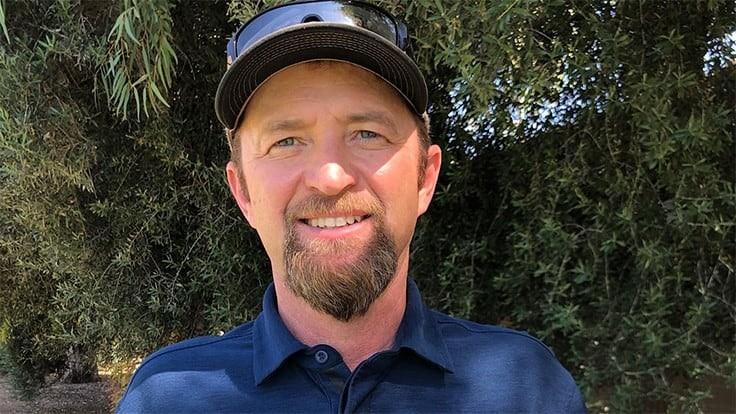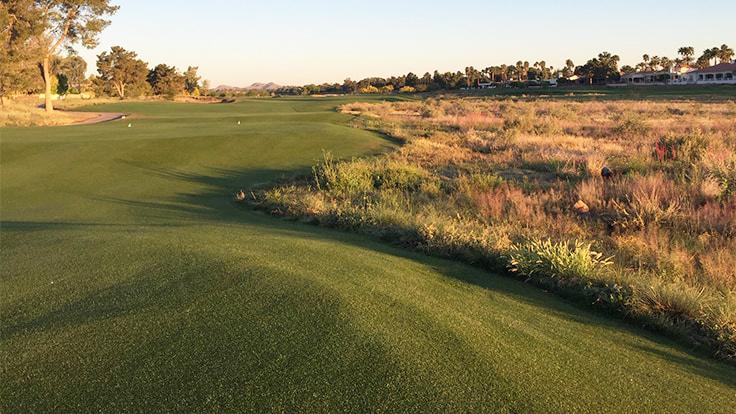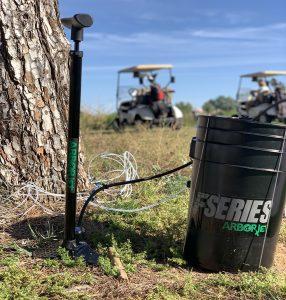Aaron Thomas was pretty sure he’d made a mistake. After a dozen years in the desert, he’d gone off to Orlando in search of … well? Come the summer of 2013, he wasn’t so sure. After just six months in Florida, he learned the director of golf grounds position had opened up at Camelback Golf Club, a JW Marriott property: 36 holes (18 of them newly renovated and poised to reopen) on 375 acres, much of it reverting to native.

The son of golf course superintendent, Thomas had long ago inherited an appreciation for experimentation. Camelback’s newly refurbished Ambiente Course was a lure, but so was the resort’s determination to reduce turf and water use. Marriott’s companywide commitment to Audubon International and other innovative environmental programs were too much to pass up. Thomas applied, was hired and arrived — back in the desert — in October 2013.
“I just love trying different things,” he says. “We have Audubon recertification coming up soon, but I see that as a kind of opportunity to experiment. For example, the Hydretain we use. If I were to speak to that, to the folks at Audubon, I’d say we are trying alternative methods to use less water (a moisture manager, in this case). It’s all good stuff in the eyes of Audubon — and Marriott, and the members here. We have tried three or four different Hydretain projects. We learn from each of them and Audubon wants to know that stuff. It shows we’re trying to limit exposure.”
Thomas arrived back here in Paradise Valley just in time to christen the Ambiente Course, which proved a sort of launching pad for all manner constructive, on-course experimentation. Led by architect Jason Straka, a partner with Ohio-based Fry/Straka Global Golf Course Design (then working under the former Hurdzan/Fry Environmental Golf Course Design banner), the renovation completely transformed what had been a flat, 40-year old course that occupied something called the Indian Bend Wash. Unfortunately, the wash didn’t drain away even normal irrigation, much less rain events.
Straka essentially lowered half the entire course footprint up to 10 feet in elevation, then used the fill to raise up the new golf holes. The effect was dramatic. Drainage capabilities, of the golf course and the wash, were restored. What’s more, the out-and-back routing had once occupied 210 acres of maintained turf; Straka’s redesign brought that number down to 90 acres — freeing Thomas to massively reduce resources, then develop and implement maintenance schedules and protocols for 110 acres of “native” area. It also allowed him to experiment with all manner of low-water-use plants, native grasses, flowers and forbes.
“When we first opened the Ambiente, it was all hydroseeded with 30 different native wildflower, grasses and desert plant species,” says Thomas, noting that this produced, among other species, 3-foot stands of Blue Grama, 8-foot acacias and seas of baby snapdragons in out-of-play areas. “It was real pretty but over the years the course has found its own little microclimates, meaning 5 to 15 percent flower coverage is what we’ve got now. It’s not a showy thing. For us, it’s sustainable and more realistic.
“Here in the bottom of Indian Bend Wash, during our rainy season, a lot of water comes through here. All that water comes in and deposits all sorts of unwanted seeds. A lot of people see ‘native’ and think reduced labor. We don’t mow it, but we have to hand pick weeds and cut trees — though we try not to formally prune or trim the trees, which saves time and labor.”

Straka envisioned massive water-use savings at the Ambiente. Indeed, Thomas confirms the new design saves between 45 million and 55 million gallons of water annually, compared to pre-2013 levels. That is the platform from which Thomas has worked these past seven years.
“It works out well for us: the more water, the more weeds,” he says. “So, if we can keep it on the dryer side, so much the better. But there are some areas out there where I‘ve added native plantings, and that’s where the Hydretain comes in. We’ve reintroduced some bare-root ocotillo out here. We don’t put them on drips. We just augur the holes and put granular Hydretain in there to help with establishment.”
Hydretain is a moisture management product from Ecologel that coats plant roots and soil particles. It deploys hygroscopic humectants (ingredients commonly used to retain moisture in things like toothpaste, gum and cosmetic products) to attract moisture already present in the soil profile — moisture in the form of water vapor or humidity that would otherwise be lost to evaporation.
“We don’t even need to water the ocotillo extra heavy to get it established,” Thomas says. “The granular Hydretain has been real effective… On our other course, the Padre, we’ve been playing around with it on tee boxes and green surrounds — to hold more moisture in the turf canopy [where spots traditionally get dry]. With the Hydretain, we create a sort of artificial humidity to get more Bermuda growth and I think that has worked.”
Thomas doesn’t need to experiment with Hydretain in the overseeding context. Superintendents across the nation’s southern tier have long used the product to assist germination and reduce irrigation when overseeding. “We typically run six to seven cycles of water when growing rye in fall,” Thomas says. “We can run a cycle or two less with Hydretain holding water in a seed bed and soil. I think we got just as good germination and density. I thought it might speed up germination, but I haven’t seen that so much. But if you’re dealing with water restrictions, it’s a great tool.
“With those bare root ocotillos, for example, we really did just water as normal. Any extra moisture is held right there in the rhyzosphere. For the price of it, it’s well worth it. Two scoops of Hydretain, one of mulch.”
An upstate New York native, Thomas couldn’t get to the Southwest fast enough. At Ohio State, he majored in turfgrass science and interned at Troon North. Assistant stints at Desert Mountain (Cochise) and Wildfire Golf Club led to his first head superintendent’s job, in charge of the Tournament Course at Dove Mountain in Marana, Arizona. He did a year at the Shadow Ridge Resort in Palm Desert, California, before returning to Dove Mountain as director of golf grounds. He wasn’t in Orlando a year before missing all this, returning to the desert, and taking the helm at Camelback.
The renovation at Ambiente didn’t merely provide Thomas a new course to maintain. It ushered in a suite of programs and expectations (some formal, others self-imposed) around which his day-to-day work would be shaped — around which it’s still shaped. The Audubon effort took hold post-renovation (Marriott-managed courses abide by the Audubon ethic companywide today). But Straka’s renovation also included installation of a Toro Lynx Control System, the computer-based irrigation program that has proved central to Thomas’ water conservation efforts.

In the desert, water (or the absence of it) drives everything. It certainly drove most every aspect of the renovation: Where the Indian Bend Wash flowed through the property, it too was renovated and retooled. It is continually tweaked and replanted by Thomas and his staff, to this day.
“It’s a drainage way that starts in the mountains to the far north of Ambiente,” Straka explains, “and generally flows southerly, entering the course at the north end of Marriott’s property, then flows through the middle of both courses and exits at the outer end of the Padre course.”
Meandering throughout the wash is a 50-foot wide trough known as the “low-flow channel” — the path water from smaller storms takes as it runs throughout the two courses. Over time, deposits and silt within the wash diminished its ability to perform its drainage function in the flooding, normal rainfall or even irrigation contexts. Straka and Marriott’s project engineer, Len Erie, removed the silt deposits and reconfigured the channel to ensure the required volume of water could be accommodated during a storm.
As happens everywhere in the desert, this work naturally created new habitats — as did Operation Pollinator, which arrived at Camelback along with the renovation. This program, sponsored by Syngenta, aims to enhance the number of pollinating insects on property by creating specific habitats tailored to conditions and specific species.
The creation and maintenance of so many distinct micro-habitats has naturally made Thomas that much more sensitive to the loss or degeneration of existing/pre-existing habitats.
“We’re in Paradise Valley, surrounded by Scottsdale, and four to five years ago, I started seeing pines in the surrounding area starting to go off-color,” Thomas says. “You see them flag out on the branches and then, in a few months, they’re toasted. I had several arborists out here. Tree health is a long chain of events, of course. We had serious construction here before I arrived. It might be unseasonably warm … But I kept seeing it. Finally, I met a guy who worked with my arborist — a guy who spent time with the Arizona Forest Service. Together they helped me identify these Mediterranean bores.”
Thomas estimates he probably had 250 of these 70-foot Afghan and Aleppo pines when he arrived in 2013.
“We lost 20 of them to this Mediterranean pine beetle,” Thomas says. “After this identification, we tried some soil treatments, fungicides, fertility. This arborist is the guy who suggested we try the TREE-äge. We’ve treated 90 trees and have enough product to do 40 more. Last summer was our first treatment and I can see the difference. At a certain point, there’s just too much die-back; they’re too far gone to treat. But I’m seeing less flagging in the treated trees.”
The plant- and tree-health company, Arborjet, manufactures TREE-äge. The product is most commonly deployed by folks looking to combat the Emerald Ash bore, but the TREE-äge R10 product, equipped with insecticide, has proved effective in dealing with the pine bark beetle and, according to Thomas, the Mediterranean pine beetle. Unlike many tree treatments, Thomas and his crews inject the product themselves, using Arborjet’s Tree IV system.
“We’re trying to get out ahead of this,” Thomas says. “If we’re successful, the symptoms will just go away in a year or two. When you have 200 trees and they’re $30,000 apiece, that’s a lot of assets that need protecting. You’ve got to buy the injector, but I worked it out: The treatment is $65 per tree.
“We went out with some products along the same lines, some fertility phosphites, did some deep injection deal (to a depth of 6 to 8 inches) that we hooked up to our 300-gallon tank. And that took just as long as doing the Tree IV and I didn’t feel as good about it. Using a pesticide and not getting it out there in the environment — I think it makes sense. You know, this is one of the wealthiest parts of the state. The homeowners here, they see us out there doing this, they like it. They like that we’re not trying blast the insecticide up in to the air or get into some kind of soil drenching. Some of those people have pines on their property. They’ve gotta think we’re being proactive about their property.
“I’ve talked to a couple [superintendents] close to me and they haven’t taken the time or shown the desire to do all this. That’s fine. But I have a degree in horticulture. I used to be a tree guy at heart; I just switched over to turf. The Arborjet team came out and trained us. We saw the injection process was pretty darned easy and if contractors come in, they’d do it for five times the cost.”
By: Hal Phillips is a Maine-based freelance writer, managing director of Mandarin Media, Inc.
See the article in Golf Course Industry here.
